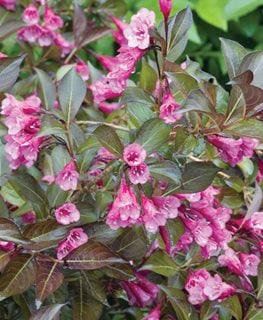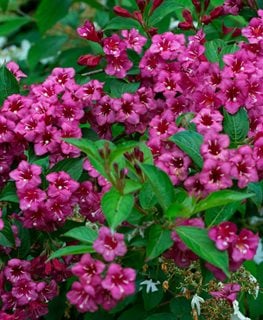How to Grow & Care for Weigela
Grow this easy-care shrub for its cheerful spring bloom and fabulous foliageFor sheer romantic charm, few ornamental plants rival the character and beauty of weigela. This old-fashioned deciduous shrub, which bears profuse clusters of flowers in spring, is virtually carefree, save for a bit of pruning and watering.
The tubular-shaped flowers, which come in various hues, are especially attractive to hummingbirds and butterflies. With a wide range of foliage colors—from creamy variegation to nearly black—and an array of sizes, there’s a suitable variety for nearly any landscape need.
A member of the honeysuckle family, weigela is native to parts of Asia. Hardy in many regions of the US, breeding breakthroughs have resulted in newer cultivars with different colors, increased vigor, and compact sizes that are suited for smaller yards.
On this page: Basics | Planting | Care | Varieties | Choosing the Right Weigela | Landscaping Tips | FAQs
On this page:
- WEIGELA BASICS
- PLANTING INSTRUCTIONS
- WEIGELA CARE
- WEIGELA VARIETIES
- HOW TO CHOOSE THE RIGHT WEIGELA
- WEIGELA LANDSCAPING TIPS
- FREQUENTLY ASKED QUESTIONS
WEIGELA BASICS
Zones:
4-8, with a few exceptions
Habit:
Arching, upright, mounding or spreading habit
Height/Spread:
Size varies from 12 inches tall and 18 inches wide, up to 10 feet tall and 12 feet wide.
Exposure:
Plants bloom best in full sun, but can tolerate partial shade. Varieties with gold, chartreuse, or purple foliage will hold their color better in full sun. Those with variegated foliage can burn with too much afternoon sun in hotter climates. Provide afternoon shade in Zone 8 or above for all varieties.
Bloom time:
Mid-late spring, with sparser rebloom in summer and fall.
Color and characteristics:
These deciduous shrubs produce tubular five-lobed flowers, 1 to 2 inches long. Flowers come in shades of red, pink, white, and yellow. Some cultivar lines feature multi-toned blooms. Foliage is 2-6 inches long, sometimes glossy, and oblong-shaped with a slightly serrated edge. Leaves are green, chartreuse, gold, variegated, burgundy, or deep purple. Fall color is insignificant.
Toxicity:
Weigela is not considered toxic to pets or children.
PLANTING INSTRUCTIONS
When to plant:
Cooler months during spring or fall are the best time to plant to avoid transplant shock from extreme summer heat.
Where to plant:
Choose a sunny site with moist, well-draining soil. Consider a spot where you can enjoy the blooms from inside and out and watch the hummingbirds dart about.
How to plant:
Dig a hole to the same depth as the root ball and 2-5 times as wide. Break up the soil and mix 15-20% compost into the backfill. If the plant is root bound, tease out the roots or slice the root ball in several places. Set the plant in the hole and cover the root ball with backfill to just below the top of the rootball; avoid covering the top of the rootball or the stem with soil. Water deeply, then mulch with loose organic matter, avoiding the stem. Continue to water regularly until established.
WEIGELA CARE
Watering:
Weigela need consistent moisture when young, about 1 inch of water per week from rainfall or irrigation, because steady soil moisture helps roots establish. Once established, they are fairly drought tolerant and usually only need deep watering during extended dry spells. In hot, dry climates, soak the root zone every 10–14 days to prevent stress. Container-grown plants dry out faster and may require watering every few days in summer.
Soil:
Weigela grows best in moderately acidic to slightly alkaline soil, with a pH between 5.5 and 7.5. Soil should be moist and well-draining.
Amendments & fertilizer:
Use a balanced slow-release fertilizer (i.e., 10-10-10) in early spring to support bud set without pushing excess leafy growth. Apply around the root zone according to package instructions. Mulch with several inches of organic matter to add nutrients, suppress weeds and conserve water.
Pruning and deadheading:
Weigela bloom on last year’s wood, so do major pruning right after spring flowering. If you prune too late, you’ll cut off next year’s flower buds. Dwarf types stay within 1–3 feet, so pruning is typically limited to removing a few wayward stems right after bloom.
Early spring (annual cleanup):
- Remove dead or damaged branches as plants begin to leaf out.
As the University of Iowa Extension and Outreach notes, weigelas are prone to winter dieback, so carefully examine plants in late winter and prune out any dead wood. - Trim back any stems that look weak or crossing.
Late spring (after bloom shaping):
- Lightly prune right after flowering to shape the plant.
- Cut stems back to a healthy set of side shoots.
- For dwarf types, this is usually all that’s needed.
Every 2-3 years (rejuvenation):
- For larger, older shrubs, remove up to one-third of the oldest stems at the base in late winter or early spring.
- This encourages strong new growth and more flowers.
Reblooming types:
- These bloom on both old and new wood.
- Only do light shaping after the first flush in spring.
- Avoid heavy pruning in summer, or you’ll lose the rebloom.
See more on pruning in our seasonal shrub pruning guide.
Diseases and pests:
Healthy specimens are virtually free of pests and diseases. Possible insect problems include aphids, spider mites, mealybugs, or scale. Fungal diseases can include powdery mildew, botrytis, twig blight or leaf spot.
Deer resistance:
Deer will leave weigela alone for the most part, though extreme conditions can result in deer grazing on plants they wouldn’t otherwise.
Troubleshooting:
- Yellowing leaves (chlorosis): Often caused by soil that is too alkaline (high pH) or poor drainage. Test your soil and amend as needed.
- Sparse or no blooms: Usually the result of too much shade, pruning at the wrong time, or excess nitrogen fertilizer. Ensure 6+ hours of sun, prune right after flowering, and use a balanced fertilizer in spring.
- Scorched foliage on variegated types: Variegated cultivars can burn in strong afternoon sun. Plant where they’ll get morning sun and light afternoon shade, especially in hotter climates.
WEIGELA VARIETIES
HOW TO CHOOSE THE RIGHT WEIGELA
Take a tour with Stacey Hirvela of Proven Winners ColorChoice Shrubs to see which weigela is right for you!
With so many sizes and colors to choose from, here are some tips to consider:
For borders and large-scale landscapes:
Choose varieties that will mature to a bigger size and have the most eye-catching foliage and flowers. Mass as hedging, or use in combination with other complementary plants for maximum visual impact.
For containers and small yards:
Dwarf types will stay smaller and not overwhelm a space. They require the least amount of maintenance when it comes to pruning, a bonus for busy lifestyles. Use as edging along borders or pathways, or as foundation plantings near your home.
For bedding displays:
Varieties with a low, spreading habit can be massed in a garden bed or along a slope.
WEIGELA LANDSCAPING TIPS
There are many ways to incorporate this easy-care shrub into any landscape. Here’s how:
- Use gold or variegated forms to brighten up lightly shaded spots.
- Combine a dwarf specimen with small perennials or conifers in a decorative container by your home’s entryway for a welcoming display.
- Mass a dwarf variety along a pathway as a low-growing hedge and keep neatly clipped for a formal effect.
- Plant small to medium-sized varieties along your home’s foundation where they won’t become overgrown and obstruct window views.
- Mass a low-growing, spreading variety along a slope for a quick-growing groundcover.
- Create a hedge along your property line with a larger variety that will fill in to create privacy.
- Plant a variety with exceptional foliage color at the end of a pathway to draw your eye through the landscape.
Combine with other plants that will complement the foliage and flowers. A burgundy-leafed form will stand out when planted next to a ‘Blue Star’ juniper or ‘Golden Charm’ cypress. Plant a gold-leafed weigela next to a blue-flowered hydrangea for a dazzling summer display. Companions such as peonies, delphinium, iris, spirea, and rhododendron will bloom at the same time as weigela for a stunning spring show.
FREQUENTLY ASKED QUESTIONS
Why isn't my weigela blooming?
The most common causes are too much shade, pruning at the wrong time, or excess nitrogen fertilizer. Weigela need at least 6 hours of sun, pruning right after spring bloom (not in fall or early spring), and a balanced fertilizer to set flower buds.
Can weigela grow in containers?
Yes, dwarf varieties like My Monet® or Spilled Wine® do especially well in pots. Choose a container that’s at least twice as wide as the nursery pot, use a well-draining mix, and water more frequently in summer since pots dry out quickly. In cold zones, protect containers in winter by moving them to a sheltered spot because roots in pots experience colder temps than in-ground plants.
Do deer eat weigela?
Weigela are generally deer-resistant, meaning deer usually pass them by. However, no plant is completely deer-proof. If food is scarce, deer may nibble on the tips, especially in winter or drought conditions.
Is weigela toxic to pets?
Weigela is not listed as toxic to dogs, cats, or children and is generally considered safe. Still, it’s best to discourage pets from chewing on garden plants to avoid stomach upset.
Can I hard prune a neglected weigela?
Yes, older shrubs can be rejuvenated by cutting up to one-third of the oldest stems back to the ground in late winter or early spring. This stimulates strong new shoots. It may take a year or two before flowering returns to full strength, but the plant will be healthier long term.
ABOUT THE AUTHOR
Janet Loughrey is a veteran garden writer and photographer with over 25 years of experience, contributing to major publications like Garden Design, Better Homes and Gardens, and Sunset. A former Master Gardener, she brings hands-on expertise from gardening in a wide range of climates, from upstate New York to the Pacific Northwest.
RELATED:
14 Best-Flowering Shrubs
25 Low-Maintenance Shrubs
Guide to Growing Shrubs
21 Low-Maintenance Plants
The 24 Best Plants to Attract Hummingbirds













